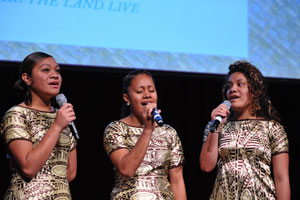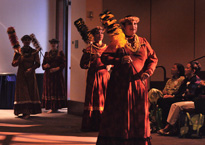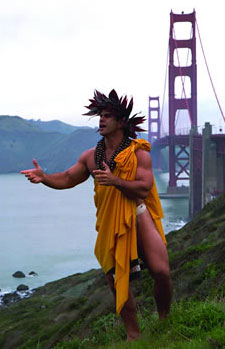2011 Program
Hawai‘i Convention Center, Honolulu, Hawai‘i
Saturday, Oct 29, 2011
7:30am thru 5:00pm
Featured 2011 themes:
- Ancient Women of Hawai‘i, morning session
- Women Activists, afternoon session
CHECK-IN
 | Charlot Courtyard, adjacent to Theater 310, Meeting Level 3. |
Living Museum Displays in the Jean Charlot Courtyard
Hawaiian artisan display and demonstration- caretakers of an art form for the next generation.
Japanese Female Immigrant Clothing in Hawai‘i from the Barbara F. Kawakami Textile Collection of the Japanese Cultural Center of Hawai‘i, with curator Audrey Kaneko (Muromoto)
Female textiles from Hawai‘i's early picture bride era. Exhibit curator shares the rich stories associated with female immigrant clothing which illuminates labor history (women's work clothing & accessories), female entrepreneurial spirit (home-based dressmaking enterprises creating ceremonial bridal and obon dance kimonos, mu‘u mu‘u for casual wear), and social history as revealed in cultural & family ritual clothing (Buddhist celebrations, Boys'/Girls' Day, and funeral attire).
MORNING PRESENTATIONS
Opening ceremony
Farrington High School students (currently enrolled and recent graduates) perform selections from the May Day and the 75th anniversary celebrations of their iconic Kalihi campus. National Anthem and Hawai‘i Pono‘ī sung by T Unique, a Samoan sisters group featuring Gataiala (Ala) Mailealo, age 17; Easter Mailealo, age 18, and Lafo Mailealo, age 19. The group is wearing, puletasi, a traditional Samoan two-piece dress worn to cultural outings, church, and other significant events.
Opening ‘oli (chant) by Kumu Hula Patrick Makuakāne of Nā Lei Hulu I Ka Wēkiu
Welcome by Robert Buss, Executive Director, Hawai‘i Council for the Humanities
Mormon Missionary Women in Hawai‘i from 1851 to 1895
Examines their experiences working with Latter Day Saints Hawaiian women such as Princess Nahinu Kamehaokalani [1849-1882] and the Women's Relief Society (Hui Manawale‘a) as a model for Queen Kapi‘olani's [1834-1899] charitable organization Ho‘oulu Lāhui Society (Association to Renew the Health & Life of the Race).
Presenters: Riley Moffat with Ishmael W. Stagner, Ph.D., Brigham Young University-Hawai‘i
Daughters of Haumea: Ancient Women of Hawai‘i
Series of hula dances interpreting the roles pursued by nā wāhine Hawai‘i (native Hawaiian women)
and the fundamental balance in the Hawaiian identity, in which the male and female principle lived in sacred equilibrium. The presentation opens with a portrayal of the goddess of Haumea (she who gives birth), also known as Earth Mother- the real Hawaiian Eve, as the foundation, the inspiration, the cultural backdrop for the Hawaiian women we see later in the presentation.
The dances blend hula kahiko (ancient hula/pre-Western contact style) with Kumu Patrick Makuakāne's signature hula mua (hula forward) in which traditional movements are put to unexpected modern music.
Presenters: San Francisco-based Kumu Hula Patrick Makuakāne with Nā Lei Hulu I Ka Wēkiu
Native Hawaiian Panel Discussion
Ancient Hawaiian women's relevance and influence on 21st century culture & the transformation of Hawaiian practices as a living and expanding culture, inherent with co-existing tensions that together demonstrate a vigorous regional culture, rather than a provincial one.


 Panelists: Hawaiian cultural leaders Vicky Holt Takamine and Patrick Makuakāne. Moderator: Noelle M. K. Y. Kahanu, Project Manager, Bishop Museum.
Panelists: Hawaiian cultural leaders Vicky Holt Takamine and Patrick Makuakāne. Moderator: Noelle M. K. Y. Kahanu, Project Manager, Bishop Museum.
Homage to Women in Transition
Filipina American poets give poetic voice to women's evolving lives, with complications, detours, mid-life reinventions, and triumphs.
"Eve" by Darlene Rodrigues
"Crystal Lei Maria Clara Mendoza" by Amalia Bueno
"Mommy" by Faith Pascua, senior at Farrington High School, and Youth Speaks Hawai‘i
Living Museum displays, Book Bazaar, and Marketplace
AFTERNOON PRESENTATIONS
Hawai‘i Women's Suffrage Movement
Explores the multi-decade tale of activism in Hawai‘i leading up to the 1920 adoption of the 19th Amendment to the U.S. Constitution granting women the right to vote. Highlighted early activists include Mary Tenney Castle [1819-1907], Mary Elizabeth Parker [1805-1897], and Wilhelmina Kekelaokalaninui Dowsett [1861-1929]. Examines the Hawaiian perspective of women's suffrage, including Queen Lili‘uokalani's views on women's voting rights after her reign (1893-1917).
Presenters:
Maenette K.P. Benham, Ph.D., Dean, Hawai‘inuiākea School of Hawaiian Knowledge, UH Mānoa
Ronald C. Williams Jr., Ph.D. candidate, Hawaiian History, Department of History, UH Mānoa
Hannah Miyamoto, Ph.D. student, Sociology Department, UH Mānoa
M. Puakea Nogelmeier, Professor of Hawaiian Language, Hawai‘inuiākea School of Hawaiian Knowledge, UH Mānoa and HCH Board of Directors
Moderator: Craig Howes, Ph.D., Director, Center for Biographical Research, UH Mānoa.
Women of action: Dora Moon [1877-1971] and the Korean Women's Relief Society
Arriving with the first wave of Korean immigrates to work on Hawai‘i's sugar plantations, Dora Moon was a pivotal organizer of a modern Korean women's movement in the Territory of Hawai‘i responding to the Japanese occupation of the Korean peninsula. Following the "March 1st Movement" in Korea in 1919, which resulted in scores of Koreans killed, beaten, or arrested by Japanese military authorities, Moon organized Hawai‘i's Korean women to take action at the 1919 Women's Congress in Honolulu and helped to form the Korean Women's Relief Society (1919-1945) whose activities and convictions supported women and children in Korea.
Presenter: Julie Rancilio, Ph.D. candidate, Assistant Professor of History Kapi‘olani Community College
5 Year Anniversary Acknowledgements
Milestones the community effort behind capturing women's history at the grass roots level
Presenter: Jamie Conway, Program Director and Founder
Public Health Nursing and Social Work in 20th Century Hawai‘i
Honolulu's Pālama Settlement, Maui's Alexander House Settlement, and the Big Island's Waiakea Social Settlement are Hawai‘i examples of the settlement house movement described by historians as "one of the greatest social movements in American history" in the early 1900s. The movement brought public health nurses and social workers to impoverished communities to provide a holistic and flexible approach to strengthening families thru maternal care, nutrition, tuberculosis clinics, and primary health care. They also attracted reformist who advocated broadening education to kindergartens and vocational and industrial training.
This presentation used narratives based on oral history interviews to illustrate the public health nursing and social work legacy of the Hawai‘i's settlement house movement and beyond. Stories include:
- Harriet Kuwamoto - public health nurse who worked to control the spread of communicable diseases (TB, venereal disease, typhoid)
- Jennie Lee In - social worker of Chinese heritage who worked at Pālama Settlement and in government-sponsored programs for youth and pregnant teenagers
2011 Hawai‘i History Day
A film project on the topic of women in history, a junior division documentary, Roe v. Wade: A Moral Debate, advanced to 2011 National History Day competition.
Presenters: Youth historians Danielle Dequito, Jessica Samante, Tamara Tsuha and their teacher Dana Goldenson from ‘Ewa Makai Middle School in ‘Ewa Beach, with introduction by Robert Buss, executive director of the Hawai‘i Council for the Humanities.
Film Profiles of Women in Hawai‘i
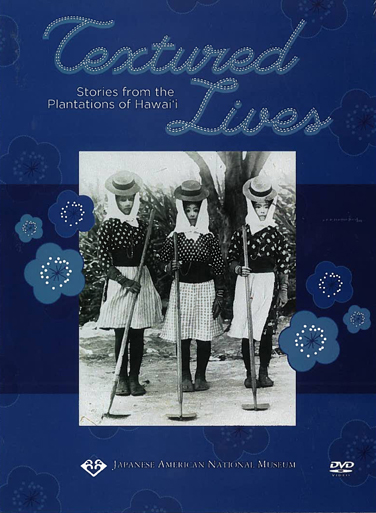 Barbara F. Kawakami: A Textured Life, by Director Akira Boch, Executive Producer John Esaki, Producer Audrey Kaneko (Muromoto) and the Japanese American National Museum, 2010, 18 minutes. Screened at the 2010 Hawai'i International Film Festival and the 2011Waimea Film Festival in Kaua‘i.
Portrays the life of author Barbara Kawakami, a Japanese immigrant dressmaker, homemaker, and college student at age 53 whose "second career" uncovered the fascinating and lost history of Japanese and Korean picture brides (women who arrived to Hawai‘i as part of a wave of arranged marriages to men known only through photographs and letters, 1907-1924) in plantation towns throughout Hawai‘i. Barbara's 1995 book, Japanese Immigrant Clothing in Hawaii 1885-1941, shared the rich stories associated with the immigrant clothing.
Barbara F. Kawakami: A Textured Life, by Director Akira Boch, Executive Producer John Esaki, Producer Audrey Kaneko (Muromoto) and the Japanese American National Museum, 2010, 18 minutes. Screened at the 2010 Hawai'i International Film Festival and the 2011Waimea Film Festival in Kaua‘i.
Portrays the life of author Barbara Kawakami, a Japanese immigrant dressmaker, homemaker, and college student at age 53 whose "second career" uncovered the fascinating and lost history of Japanese and Korean picture brides (women who arrived to Hawai‘i as part of a wave of arranged marriages to men known only through photographs and letters, 1907-1924) in plantation towns throughout Hawai‘i. Barbara's 1995 book, Japanese Immigrant Clothing in Hawaii 1885-1941, shared the rich stories associated with the immigrant clothing.
Introduction by Audrey Kaneko (Muromoto) of the Japanese Cultural Center of Hawai‘i
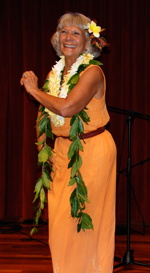 Queenie: The Spirit of a Dancer, directed by Native Hawaiian filmmaker Maile Loo-Ching, 2010, 10 minutes, featured in 2010 ‘Oiwi Film Festival. Legendary hula dancer Queenie Ventura Dowsett shares thoughts on the essence of hula. Queenie speaks about how her kumu, which includes ‘Iolani Luahine [1915-1978], passed on the knowledge of what a dancer, and a dancer's spirit possesses.
Queenie: The Spirit of a Dancer, directed by Native Hawaiian filmmaker Maile Loo-Ching, 2010, 10 minutes, featured in 2010 ‘Oiwi Film Festival. Legendary hula dancer Queenie Ventura Dowsett shares thoughts on the essence of hula. Queenie speaks about how her kumu, which includes ‘Iolani Luahine [1915-1978], passed on the knowledge of what a dancer, and a dancer's spirit possesses.
Introduction by Kumu Hula Maile Loo-Ching, Hula Preservation Society with Queenie Ventura Dowsett in from the Big Island. Auntie Queenie danced with musical accompaniment by Pa ‘ahana who play at the esteemed Halekulani Hotel. Doug Tolentino played the ‘ukulele, Pakala Fernandes played the upright bass, and Kaipo Kukahiko was on the guitar.
Closing
Hawai‘i Aloha, with Pa‘ahana, closing ‘oli (chant) by Ka ‘ala Estores Pacheco, Sophomore, California Polytechnic State University at Pomona, Kamehameha Schools Class 2010, chant selection Eō e Nā Mamo. Program Evaluation turn.
Remembering Women Cultural Treasures of Hawai‘i
The printed program featured short essays on the legacies of women cultural treasures who have passed away since our last program:
- Dr. Isabella Kauakea Aiona Abbott, age 91. Marine algae scientist & ethnobotanist, KS class 1937;
- Agnes C. Conrad, age 93. Former State Archivist from 1955 to 1982, former director of the Friends of ‘Iolani Palace, officer for the Foundation for Hawai‘i Women's History;
- "Frenchy" Keanuenueokalaninuiamamao DeSoto, age 81. Former OHA trustee chairwoman and Hawaiian activist;
- Karen Peacock, age 62. Author & curator of the Pacific Collection at UH Library, resources editor for The Contemporary Pacific: A Journal of Island Affairs, faculty at the Center for Pacific Island Studies.

